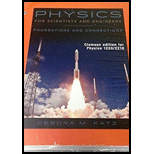
Ultraviolet (UV)
Want to see the full answer?
Check out a sample textbook solution
Chapter 34 Solutions
Physics for Scientists and Engineers: Foundations and Connections
- At a distance of 39 ft , an ionizing radiation source delivers 7.0 rem of radiation. How close can you get to the source without having any biological effects? The intensity of the radiation increases as you move closer to the radiation source according to the equation I1 / I2 =D22/D12arrow_forwardWhat is the frequency of the most intense radiation emitted by your body? Assume a skin temperature of 95°. Group of answer choices 1.81 x 10^13 Hz 6.43 x 10^14 Hz 1.65 x 10^13 Hz 3.18 x 10^14 Hzarrow_forwardFind the frequency of the radiation peak emitted by a human whose body temperature is 308 Kelvin (98 F). Group of answer choices 5.14 x 10^13 Hz 1.81 x 10^13 Hz 8.17 x 10^13 Hz 3.16 x 10^13 Hzarrow_forward
- One recent study has shown that x rays with a wavelength of 0.0050 nm can produce mutations in human cells.a. Calculate the energy in eV of a photon of radiation with this wavelength.b. Assuming that the bond energy holding together a water molecule is typical, use the given table to estimate how many molecular bonds could be broken with this energy.arrow_forwardThe photoelectric effect can be used in engineering designs for practical applications. For example, infrared goggles used in night-vision applications have materials that give an electrical signal with exposure to the relatively long wavelength of IR light. If the energy needed for signal generation is 7.5 x 10-20 J, what is the minimum wavelength? What is the frequency of light that can be detected? c = 2.998 x 10 m/s h = 6.626 x 10-34 J s marrow_forwardConsider the following statements about electromagnetic radiation and decide whether they are true or false. If they are false, correct them. (a) The total intensity of radiation emitted from a black body at absolute temperature T is directly proportional to the temperature. (b) As the temperature of a black body increases, the wavelength at which the maximum intensity is found decreases. (c) Photons of radio-frequency radiation are higher in energy than photons of ultraviolet radiation. (d) Photons of ultraviolet radiation have less energy than photons of infrared radiation. (e) The kinetic energy of an electron ejected from a metal surface when the metal is irradiated with ultraviolet radiation is independent of the frequency of the radiation. (f) The energy of a photon is inversely proportional to the wavelength of the radiation.arrow_forward
- A laser beam of power 6.0 W and diameter of 2.0 mm is directed upward at a highly reflective oil droplet of density 0.85 g/cm^3. What maximum radius droplet can be levitated by the radiation pressure of the laser beam?arrow_forwardA 193-nm-wavelength UV laser for eye surgery emits a 0.500 mJ pulse. How many photons does the light pulse contain?arrow_forwardThe microwave radiation left over from the Big Bang has a maximummagnetic field strength of 2.33 x 10 -10 T. What is the correspondingmaximum electric field strength of the wave?arrow_forward
 Physics for Scientists and Engineers: Foundations...PhysicsISBN:9781133939146Author:Katz, Debora M.Publisher:Cengage Learning
Physics for Scientists and Engineers: Foundations...PhysicsISBN:9781133939146Author:Katz, Debora M.Publisher:Cengage Learning Principles of Physics: A Calculus-Based TextPhysicsISBN:9781133104261Author:Raymond A. Serway, John W. JewettPublisher:Cengage Learning
Principles of Physics: A Calculus-Based TextPhysicsISBN:9781133104261Author:Raymond A. Serway, John W. JewettPublisher:Cengage Learning

